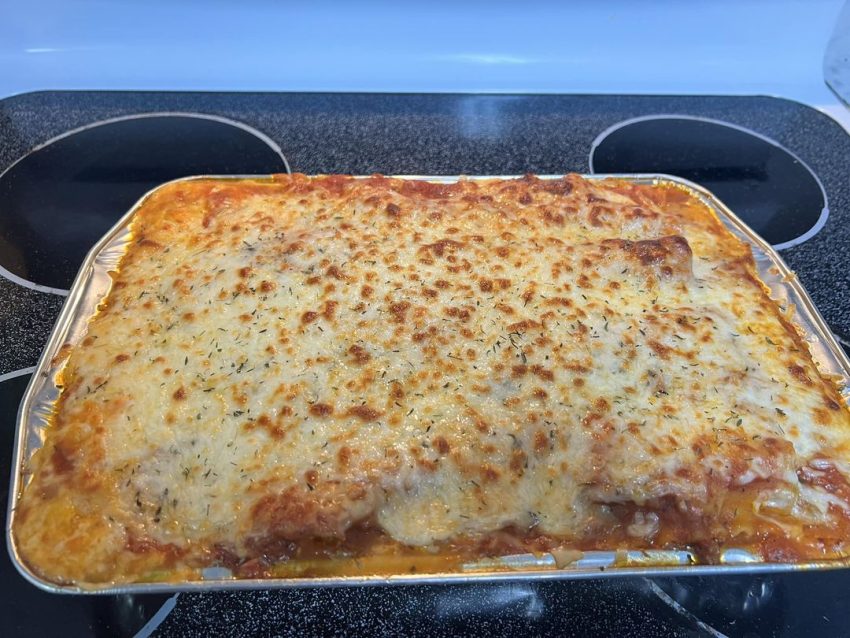One of the most loved foods in the world! This is a lasagna made the traditional Italian way, with a slow cooked ragu and a béchamel sauce (“Besciamella”). No ricotta – that’s the American-Italian version. Though it requires patience to make, it is worth every minute. The ragu bolognese is melt-in-you-mouth tender and the sauce is rich and thick. Makes 8 giant or 10 normal servings.
PREPARATION TIME
Ingredients
RAGU BOLOGNESE:
1 tbsp olive oil
1 onion , finely chopped (white, yellow or brown)
1 medium carrot , finely diced
1 rib / stick of celery , finely diced
2 garlic cloves , minced
1 kg / 2 lb beef mince (ground beef) (Note 1)
800g / 28 oz crushed tomato
1/4 cup tomato paste
1 cup (250ml) red wine , bold not light (Note 2)
3 beef bouillon cubes , crumbled
2 bay leaves , dried or fresh
1/2 tsp each dried thyme and oregano
2 tsp Worcestershire Sauce
1 – 2 tsp sugar (if needed – Note 3)
1/2 tsp salt and black pepper
CHEESE SAUCE (BESCIAMELLA):
60g / 4 tbsp butter
1/2 cup (75g) flour
4 cups (1 litre) milk (I use low fat)
2 cups (200g) shredded cheese (Colby, Gruyere, Cheddar, Monterey Jack, OR 1 cup shredded parmesan)
Pinch of freshly ground nutmeg
Salt and pepper
LASAGNA:
350g/ 12 oz fresh lasagna sheets (or 250g/8oz dried) (Note 5)
1 1/2 cups (150g) shredded mozzarella cheese
Finely chopped basil or parsley , for garnish (optional)
Instructions
RAGU:
CHEESE SAUCE:
ASSEMBLE:
Recipe Notes:
2. Use a bold red, like cab sauv, not a light one like pinot. You can skip the wine if you prefer, just use water instead, or beef broth/stock.
3. Sugar – add this only if you think your sauce has a tinge of sour which can occur depending on the quality of the tomatoes used.
4. Cheese: Use any flavoured melting cheese you want. I don’t recommend mozzarella because it doesn’t have enough flavour. Also, I have recently discovered that some Tasty Cheese brands do not melt well in béchamel sauces, it can make it a bit floury rather than silky smooth. So it is safest to avoid Tasty cheese. (Tasty is a popular type of Australian cheese).
5. Fresh vs dried lasagna sheets: I like using fresh because I feel that it “melds” better with the filling. For DRIED Lasagna sheets, check the packet to see if it needs to be cooked before using. If it’s labelled “Instant” or “No Cook”, then you can use it without pre-cooking. If it needs to be cooked in boiling water (like pasta), follow the packet directions but regardless of what the packet says, I would recommend adding a good glug of olive oil in the water before adding the lasagna sheets (extra assurance they won’t stick together).
If you use instant dried lasagna sheets, the surface probably won’t stay nice and flat, like you see in the photos, as it tends to get “waves” on the surface once cooked. No effect on flavour, it’s just visual. Also see Note 5 re: sauciness of ragu for dried instant lasagna sheets (for cooked dried sheets, it essentially becomes fresh lasagna sheets).
Fresh lasagne sheets are sold in the refrigerator section of supermarkets.
6. Ragu Consistency & Making ahead: The Ragu shouldn’t be watery and there shouldn’t be an excessive amount of sauce. However, if you are using dried lasagna sheets, you do need to ensure that there is enough liquid to rehydrate the sheets. See video to see how saucy my ragu is – this is saucy enough for dried lasagna sheets.
If you aren’t using a heavy based pot, you may find you need to add a splash of water during the cook time (heavy pot = heavy lid = clamps down better = less water evaporation).
If you make the sauce ahead (I often do), reheat the ragu and you may need to add a splash of water. Reason is that if you leave it overnight in the fridge, it thickens and is harder to spread, plus if you are using dried sheets there may not be enough liquid to rehydrate the lasagne sheets / this sucks out all the liquid from the sauce leaving you with meat layers that aren’t that saucy in the finished lasagna.
7. SHEET PLACEMENT: If you watch the video, you will see I place the sheets in one direction for one layer, then the next time I place them 90 degrees the other way. This just helps the sheets stay in place a bit better when cutting – but it’s not a big deal!
8. Though there are many versions of Lasagna throughout Italian, typically, strictly authentic Italian Lasagnas are usually made with pancetta, milk and a mix of pork as well as beef in the ragu. They are also made with passata rather than crushed tomato, has not tomato paste, bouillon cubes or Worcestershire and quite often made with white rather than red wine.
Mine is a more “everyday” version and while those with a refined palette or purists may be able to taste the difference, I love my version as it is. The reason I add the extra ingredients is because I feel they add an extra something-something, especially given I make this with every day store bought ingredients, not fresh ripe seasonal ingredients. I do on occasion make authentic Italian versions, but this recipe is the version I make the most often, which is why I’m sharing it.
9. MAKE AHEAD: Lasagna is brilliant for making and and freezing. Cover with foil and reheat in the oven at 180C or microwave it (this is my preferred because I feel like it keeps it more moist). If frozen, defrost before heating. Keeps for 3 days in the fridge.
Alternatively, assemble then bake later. Just let the sauce cool a bit then assemble the lasagne and bake later – up to about 24 hours is fine.
